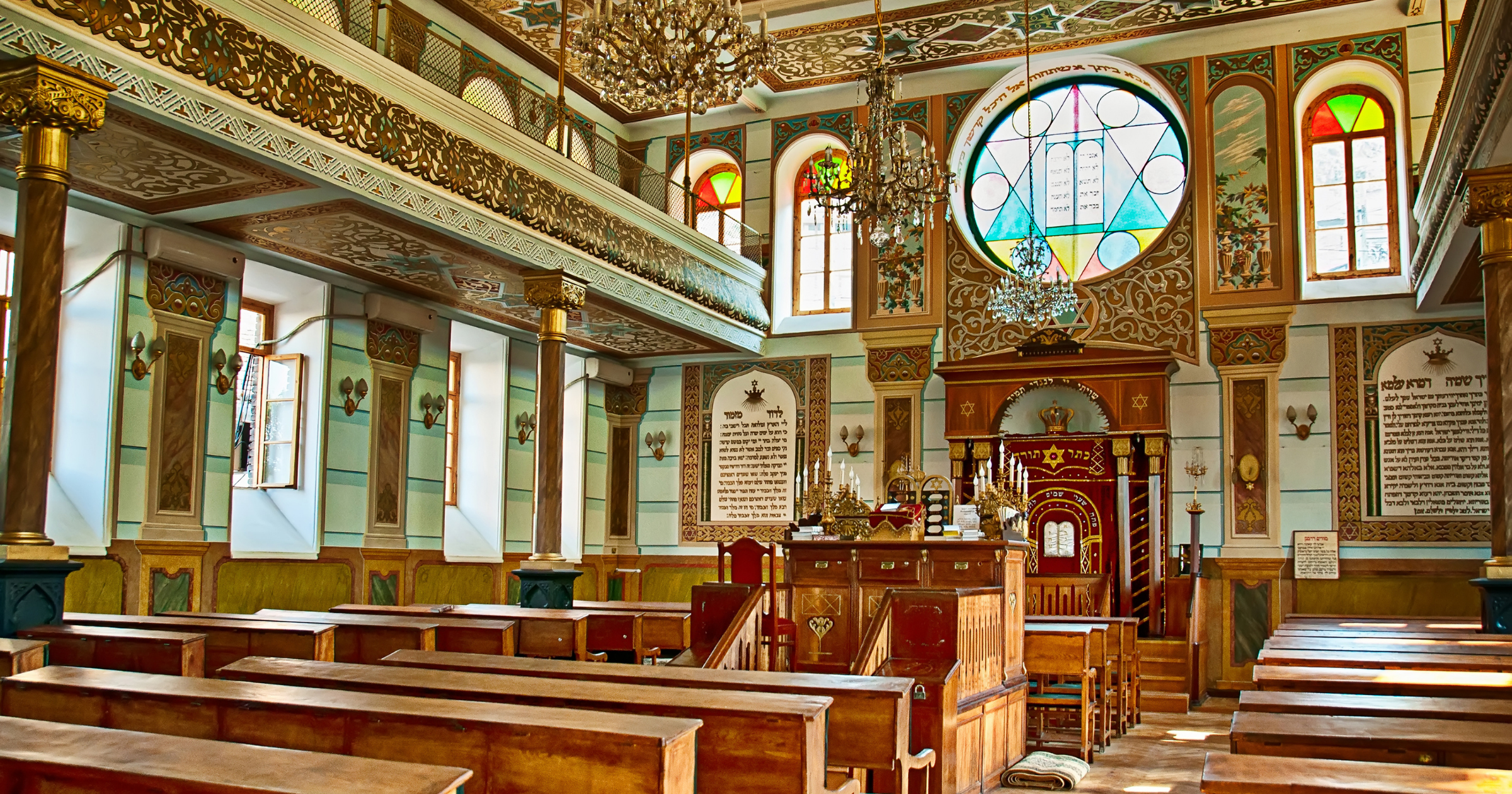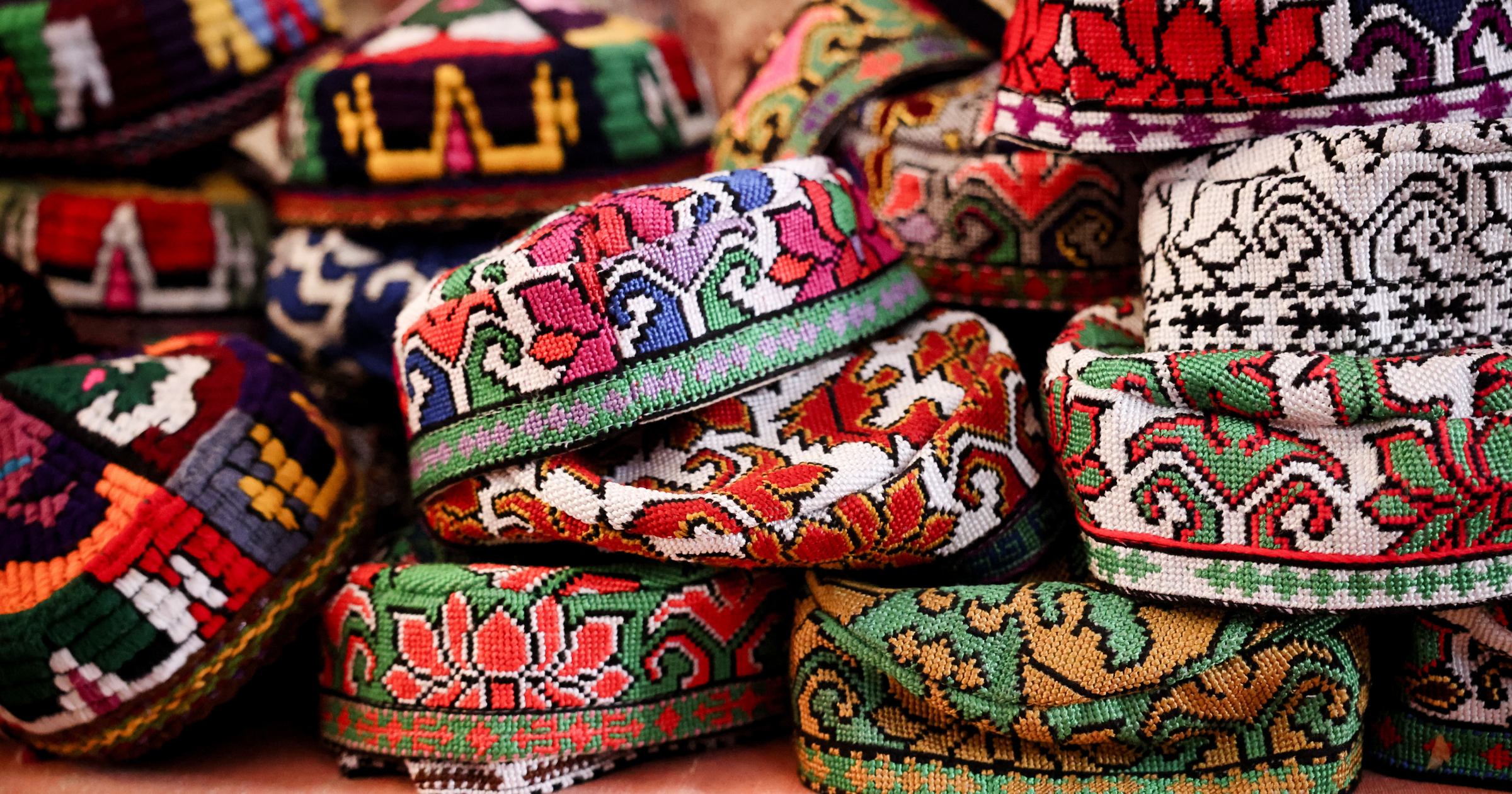The Jewish Traveler
A Jewish Journey Along the Silk Road

In 1997, my son began studying for his bar mitzvah with Rabbi Yitzhak Nates, whom he had met at Boy Scout camp. I was struck by the rabbi’s warmth and his enthusiasm—and by his vibrant, bowl-shaped kippah embroidered in colorful silk. “It’s Bukharan,” he told me. I had no idea where Bukhara was, but the name, and the kippah, stuck with me.
Years later, I’d found Bukhara on the map, in Uzbekistan. On a food tour in 2023 in Queens, N.Y., home to more than 50,000 Bukharan Jews, I also savored the region’s delicious cuisine. That taste reignited my long-ago spark of curiosity, resulting in a travel plan for my husband, Ted, and me.
We set off for Uzbekistan in September 2024. We visited Bukhara, Samarkand and Tashkent, important hubs on the Silk Road, the ancient trading network that spanned 4,000 miles from China to Rome. Since we would be “in the neighborhood,” we added Georgia and Armenia to the itinerary.
Uzbekistan, Georgia and Armenia may seem an unlikely trio, spread across Central Asia and the Caucasus Mountains, each with distinct languages, faiths and cultures. Yet all three were absorbed into the Soviet Union in the early 1920s and gained independence when it collapsed in 1991. It would be fascinating to see how the countries had navigated the post-Soviet years.
Staying at the Amelia Boutique Hotel in Bukhara helped set a Jewish focus on our trip. Built in the late 1800s for a wealthy carpet merchant, the hotel is in the city’s old Jewish quarter, the Mahalla-i Yahudiyan (Arabic for the Jewish quarter). Its airy interior courtyard surrounds rooms embellished with carved wood and painted plaster. The breakfast room is lined with shelves of Aladdin’s lamps and Bukharan kippahs—just like the one Rabbi Nates wore.
We soon learned that in Central Asia, nearly all men wore a head covering, and along the Silk Road, dyes, silk and skilled embroidery were plentiful. Muslims wore the doppa—a small, snug-fitting, square-edged cap. Bukharan Jews adapted it into a larger, rounder, more ornate version, now known as the Bukharan kippah.
Bukhara’s Jewish history stretches back at least 1,500 years, when Persian Jews migrated east after the Babylonian exile. Many became traders; they spoke Bukhori, a mix of Persian, Tajiki and Hebrew. Before a synagogue was built, Jews and Muslims shared space in a mosque, praying in separate corners. By 1900, Bukhara was the heart of Central Asian Jewry, home to about 25,000 Jews and 13 synagogues. Today, two synagogues and fewer than 150 Jews remain.

The mahalla is a compact maze of narrow streets, now mostly populated by Muslim families.
Its centerpiece is the Bukhara Synagogue, built in 1620 and considered the oldest surviving synagogue in Central Asia. At 75, Abram Iskhakov is still busy as its cantor and caretaker. Shabbat services follow the Sephardi tradition, introduced by Rabbi Yosef Maman in place of Persian religious customs. He traveled from Safed to Bukhara in 1793 with prayerbooks for this isolated community.
In 1800, when Maman returned to Bukhara to settle permanently, he helped establish a second synagogue. Ohel Itzhak was named for its patron, merchant Itzhak Zanbur. With a loftier ceiling and larger prayer hall, it reflected the community’s growing prosperity. The Soviets converted it into a textile factory in 1938; the Jewish community reclaimed it 50 years later.
Over 10,000 Bukharan Jews are buried in the Old Jewish Cemetery, about two miles south of the synagogue, where some gravestones date to the 1500s. It’s one of the oldest Jewish cemeteries in Central Asia still in use.
We met Jama, our guide and the Amelia hotel owner, on our second day. Over tea, he shared his story: His mother was Muslim, his father was Jewish—and a respected doctor. “When I was a child, my father had me study the Koran,” he said. “It was a way to blend in—protection, if it was ever needed.”
Jama knew everyone in town. In the Trading Domes, the series of marketplaces where 16th-century Silk Road jewelers, hat sellers and textile merchants once gathered, he introduced us to blacksmiths shaping hot steel into knives and tea vendors making custom blends for tourists and locals.

When it was time to leave Bukhara, the high-speed Afrosiyob train whisked us east in under two hours to Samarkand. The city’s crowning jewel is the 500-year-old Registan, the grand square where royal decrees were made, merchants bartered and students learned in three colossal madrasas, which are now popular landmarks rather than study halls. Each time our guide Amin said “madrasa,” Ted and I thought “midrasha,” the Hebrew word for a place of study. Different traditions, same Semitic root—meaning “to learn” or “to study.”
The Jewish mahalla, a 15-minute walk northeast of Registan, was home to nearly 40,000 Jews before World War II. Once there were Jewish schools, markets and 30 synagogues; today, only the Gumbaz Synagogue remains. Plain outside but ornate within, its domed ceilings display intricate mosaics and Stars of David. It hosts Sephardi Shabbat and holiday services for the few dozen local Jewish families.
Our last stop in Samarkand was the Gur-e-Amir Mausoleum, the final resting place of Amir Timur, the 14th-century Mongol conqueror also known as Tamerlane. His grand, glittering tomb is said to have inspired the Taj Mahal.
A two-hour train ride further east brought us to Tashkent, Uzbekistan’s capital. With its massive government buildings, wide boulevards and enormous public squares, the city’s 70 years under Soviet rule are clearly visible.
Soviet grandeur is visible underground, too. The Tashkent Metro, Central Asia’s first subway system, opened in 1977. Each station is a work of art, with opulent chandeliers, mosaics and themes honoring cosmonauts, poets and the local cotton industry.
We dove into the Chorsu Bazaar, a huge market beneath a turquoise dome. The aisles overflowed with giant melons, apricots and tomatoes; the air smelled of cumin, saffron and paprika. Here, in the late 1800s, Jewish merchants traded silk, spices and textiles, and their prosperity funded synagogues, schools and houses with courtyards in the mahalla, a 20-minute walk north of the market.

Since the collapse of the Soviet Union in 1991, and the subsequent mass emigration of Jews from all parts of the region, mostly to Israel and the United States, Chabad and the mostly American donor-supported Federation of Jewish Communities of the Commonwealth of Independent States have helped sustain Jewish life in Uzbekistan by providing rabbis, funding and social services, especially for the elderly. As of 2021, Tashkent had the largest Jewish population in the country—about 3,700 by census count, though community groups estimate closer to 8,000. The local Jewish scene is vibrant, with seven synagogues, a community center, a day camp and cultural programming.
When we reached Tbilisi, Georgia’s capital, the contrast with Uzbekistan was immediate: While the latter’s Silk Road cities arise from flat desert plains, Tbilisi lies in a steep river valley with cliffs and hilltop landmarks.
The country is predominantly Christian, under the umbrella of the Georgian Orthodox Church, whereas Uzbekistan is majority Muslim. Jews have lived in Georgia for over 2,600 years, and today Tbilisi is home to more than 3,000—a mix of native-born Jews and a growing community of Israeli and international expats.
We stayed at the Communal Sololaki Hotel—truly communal, with a shared breakfast table where we met sisters from Kazakhstan, a Russian wedding guest and a man from Kashmir now living in Sweden. From the central Freedom Square, the Sololaki neighborhood winds up a steep hillside; its faded 19th-century mansions are being transformed into trendy cafes, galleries and wine bars.
On a Culinary Backstreets walking tour, our guide Maka introduced us to a variety of Georgian specialties, including the beloved khachapuri, the boat-shaped, cheese-filled bread topped with an egg that alone makes the trip to Tbilisi worthwhile.
Before World War I, Tbilisi had about 15 synagogues; three remain. The grandest is the Great Synagogue, built in 1903 in the Moorish style, with a women’s balcony, beautifully carved wooden ark and a mikveh. Two other synagogues have been repurposed—one as the Royale District Theatre, the other as the David Baazov Museum of the History of the Jews of Georgia. Named for the Georgian rabbi and Zionist leader who died one year before the establishment of Israel, it houses a remarkable collection of manuscripts, ritual items and photographs. Highlights include national costumes and paintings by avant-garde artist Solomon Gershov, who studied at a Vitebsk art school in Soviet Russia under Marc Chagall.

We ended our journey in Yerevan, Armenia’s capital. Our hotel rooftop had a stunning view of Mount Ararat, the biblical resting place of Noah’s Ark. Like Georgia, Armenia is a Christian country.
Before our visit to the Armenian Genocide Museum, Ted and I knew little about that tragic period. Between 1915 and 1916, at least half of the Ottoman Empire’s Armenian Christians, between 664,000 and 1.2 million, died on forced marches through the Syrian desert or from massacres and starvation as the Ottoman government sought to secure Muslim Turkish dominance in the region.
Armenia’s Jewish community, which numbers about 500, is centered in Yerevan and gathers at the Mordechai Navi Jewish Center—the country’s only functioning synagogue. The Chabad-affiliated congregation holds Shabbat services when a minyan is present.
On our final night, we walked to Republic Square in the city center to see the dancing fountains, whose columns of water erupt from a reflecting pool in concert with music and colored lights.
When Aretha Franklin’s “Respect” came on, we danced. The crowd cheered, not for our dance moves, but for our tangible joy. Just like Rabbi Nates, who inspired our travels, they were warm and enthusiastic.
What to see
MIR Corp and Silk Road Treasure Tours both offer tours to the “Stans”— Kazakhstan, Kyrgyzstan, Tajikistan, Turkmenistan and Uzbekistan—and the Caucasus region. For private tour guides in Uzbekistan, World Jewish Travel is a good resource.
Uzbekistan
Bukhara is compact and easy to navigate. At its center is the Lyab-i Hauz, a shady pond surrounded by mulberry trees and teahouses where families gather for ice cream and halva.
Just south, in the old Jewish quarter, is the Bukhara Synagogue, which possesses centuries-old deerskin-parchment Torah scrolls tucked behind gold-embroidered tapestries. Next door, the Old Jewish House and Gallery displays Bukharan crafts, Judaica and historical photos of local Jewish families.
A Hebrew and Russian memorial at the Old Jewish Cemetery honors local World War II soldiers.
Four miles from the city center is the Sitorai Mokhi-Khosa Palace (The Palace of Moonlight), a 1912 country residence of the last Emir of Bukhara. It dazzles with Venetian mirrors, crystal chandeliers, elaborate tilework and peacock-filled gardens.

At the Registan in Samarkand, be sure to hire an English-speaking guide who can lead you through its nooks and crannies and reveal the behind-the-scenes stories of its three madrasas. For a more hands-on experience, try a cooking class; you’ll make the ubiquitous rice dish plov, dine with a local family and learn a bit about daily life. Viator offers reliable options.
Just one and half miles from the Registan, on a bank of the Siab River, sits the Jewish cemetery; the 15,000 graves have Hebrew, Russian and/or Tajik inscriptions. Stones show Stars of David and local floral motifs. Just uphill is the Tomb of the Prophet Daniel. Legend says that Tamerlane, the Mongol conqueror, brought the relics of the biblical prophet here from Susa (in present-day Iran). It’s one of the few places in the world where Muslims, Jews and Christians pray at the same site.
The Amir Timur Museum in Tashkent displays maps, coins and weapons that tell the story of his rise to power and of the craftsmen, scholars and artists he brought to Tashkent, making it a center of Islamic scholarship and artistic innovation.
Among the seven synagogues in Tashkent are the Great Synagogue, which follows Sephardi rites, and the diminutive Tero Street Synagogue, which feels like a family prayer house. Its ark holds Torah scrolls more than 250 years old. Arkadiy Isakharov, Tero Street Synagogue’s chairman, shares stories and artifacts with visitors.
Beneath grand arches outside and Uzbek artistry inside, the Alisher Navoiy Theater stages opera, ballet and symphonic performances. When Uzbekistan’s first opera, Buran, premiered here in 1939, one of the standouts was Fotima Borukhova, a mezzo-soprano from a Jewish family in Samarkand who went on to be named People’s Artist of the USSR.
Armenia
At the Armenian Genocide Museum, eyewitness accounts, maps and photos make the horrors feel immediate. Outside, an eternal flame and tree-lined memorial honor the victims.
Visitors are warmly received at the Mordechai Navi Jewish Center, but since the entrance is tucked away off Tigran Mets Avenue and hours are limited, it’s wise to arrange a visit in advance.
Among the 23,000 works at the Matenadaran, the Museum of Ancient Manuscripts, are gem-crusted religious texts, early medical books on surgery and Euclidean geometry. Its Hebrew collection features 126 Torah scrolls brought from Ukraine in 1986; three Megillat Esther scrolls (one in a silver cover); and fragments from Psalms, Song of Songs and Job.
Don’t miss the Cascade Complex in Yerevan—a terraced garden with sweeping staircases, modern sculptures and panoramic city views. Inside is the Cafesjian Center for the Arts, which features contemporary art and glassworks.
Georgia
In Tbilisi’s Old Town, Beit Rachel—also known as the Ashkenazi or little synagogue—was built in the 1910s and rebuilt after earthquake damage in 2009. The two-story structure features stained-glass windows, a women’s gallery and a 150-year-old Torah ark. It hosts daily and Shabbat services, and visitors are welcome; it’s best to stop by during prayer times.
Try Tbilisi’s sulfur baths in the Abanotubani district, at the edge of the Old Town. The city’s name comes from the old Georgian word “tbili,” meaning warm, which is fitting for its natural hot springs. Rich in hydrogen sulfide, the warm waters are said to ease skin, joint and respiratory issues.
The Georgian National Museum’s Exhibition of the Soviet Occupation is chilling; there are KGB documents, interrogation equipment and stories of people who resisted the regime. There’s also a remarkable collection of hominid fossils dating back 1.8 million years. Nearby, the Dry Bridge Market is a treasure trove of Soviet relics, antique jewelry and colorful local art. Vendors here are eager to share personal stories of life under Russian rule.
Joyce Eisenberg is the co-author with Ellen Scolnic of the Dictionary of Jewish Words and The Whole Spiel: Funny essays about digital nudniks, seder selfies and chicken soup memories. She lives in the Philadelphia area.











 Facebook
Facebook Instagram
Instagram Twitter
Twitter
Leave a Reply